| Cryptocrystalline means that the structure of agate comes from many small crystals cemented together with more silica. The process of making agate is most likely a solution or gaseous process and not a simple melt cooling. Molten magmas grow large crystal if cooled slowly, or random, small, crystals if cooled rapidly. The patterns found in most agates don't fit either scheme of mineral formation from a melt.
The bulk material that cements the agate together is silica and is called chalcedony. Sometimes pure chalcedonies are formed and collected for gemstone use. Green chalcedony containing nickel is also known as chrysoprase. A red variety has the name of carnelian, brown is called sard, and there are also purple and bluish colors. These materials are usually found in seams or narrow lens like openings.
Agates form in rounded nodules or in seams. This lends itself to the theory of liquid or gas crystallization. Flowing magmas (lava) often trap gases in bubbles as they cool, thus providing an ideal nursery for agate growth. Many high silica lavas with entrapped gas sphericals can be leached by rain water dissolving some of their silica content and flow through the porous lava filling the sphericals.
Over time a repeating cycle of wetting and drying of the spherical chambers might produce a pattern of periodic precipitation. If the silica changes chemistry from time to time it might well carry differing amounts of dissolved metals (colorants) into the growing agate providing bands of color.
There are many varieties of agate and it is not likely that one growth method can be found which can produce all of the various types. Many nodules contain "fortifications", or concentric bands of alternating or repeating colors. These may follow the general shape of the nodule or might form straight parallel bands across the nodule. Sometimes they do both in the same agate. The following photos show some fortification agates.
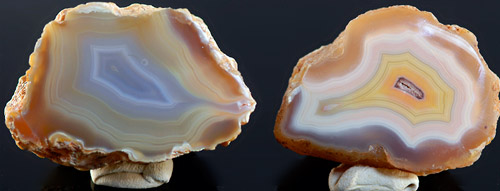 |
|
2 laguna agate nodules
|
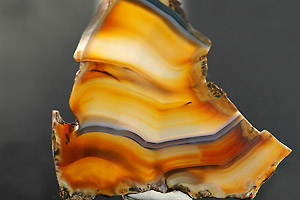 |
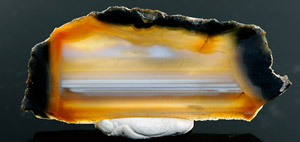 |
|
piranha agate Brazil
|
Brazilian agate
|
Another popular agate type is the "moss" agate. The moss agate gets its name from the mass of vegetable like strands trapped in the silica matrix. The moss can be of nearly any color and many moss agates have more than one type of moss. This type of structure does not lend itself well to periodic precipitation as its origin. More likely the cementing mass has already began to form a gel and color channels are created by precipitating metal hydroxides and oxides along grain boundaries.
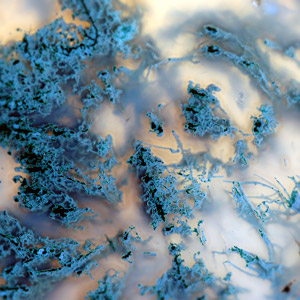 |
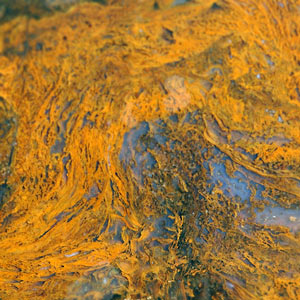 |
|
Ochoco Lake Moss
|
Needle Peak Moss
|
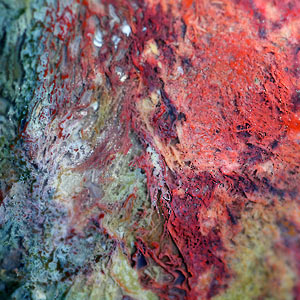 |
 |
|
Maury Mtn Moss
|
SW Texas Moss
|
Another similar type of agate is called a dendritic agate, and it contains more plant like structures, but more like ferns or small tree-like structures. These colored elements are usually made up of manganese or iron oxide. They may form via slow precipitation and metal migration caused by slow pH change in the silica gel. These may have been formed after the bulk of the calcedony was in a semi-rigid state, or perhaps in way similar to the moss agate, but with more limited mobility or fewer fractures.
The process may also be aided by "electrochemical displacement". Metals can be ordered in an activity series where they are rated n their ability to reduce other metals. (reduce: means to cause ionic precipitation to the metallic state.) Thus in the following series Mn, Fe, Co, Ni, Cu, are in order of their ability to reduce the metals below. If an iron nail (solid metal) is placed in a solution of copper (e.g. copper sulfate) the copper will plate out on the iron. Some iron going into solution to replaced the reduced copper. Synthetic dendrite structures induced in agate have been described by George W. Fischer (ref) and Vince King (ref & ref).
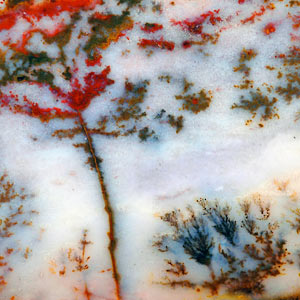 |
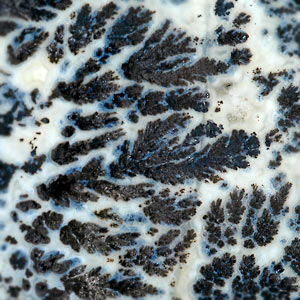 |
|
Paiute Creek Agate
|
unknown agate
|
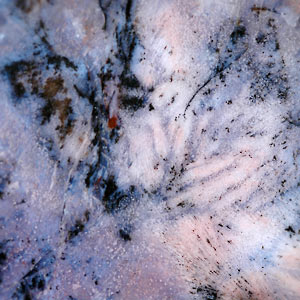 |
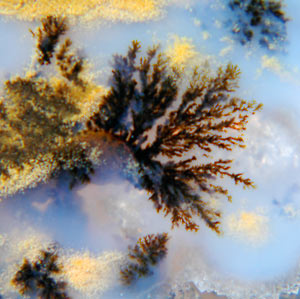 |
|
unknown Agate
|
Sheep Creek Agate
|
Another well known agate variety is the "plume" agate. The characteristic feature of this agate is basically another organic like growth that may appear as a tree, plant or feather duster floating in transparent to translucent chalcedony. Again it is likely that the plumes (mostly mixed metal oxides and hydroxides) are formed after partial solidification or gelling of the silica media. Under basic (as opposed to acidic) conditions many metal salts will produce flocculent oxy-hydroxy precipitates. If these are produced in a gel with limited migration, they might appear to be trapped as plumes or flow structures.
Although plumes are found in nodular agates they are often found in seam or vein agates too. Many times the plumes seem to be anchored to the edges of the vein or originate at the point of contact between the agate vein and the host material. There are several possible causes for this, including that the sides may offer a point of nucleation for crystal growth, or may provide the point(s) at which seepage of a basic solution intrudes in to the forming agate.
Thundereggs are another great source for plumes. Thundereggs are likely created in high-silica rhyolitic welded tuffs, where gas bubbles are frozen in time, and then filled in by silica solutions. Like most plumes, the brownish varieties are usually some form of Fe (oxy-hydroxide) (goethite, limonite, etc.), and the black varieties consist of mixtures of Mn (oxy-hydroxies) (romanechite, vernadite, etc.) White plumes appear to contain no metal(s) and are likely different phases of silica (likely hydrated) in the chalcedony. (could be opal.)
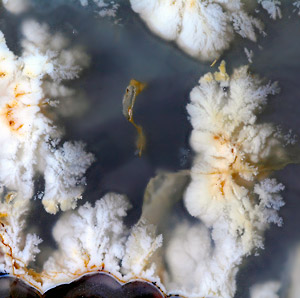 |
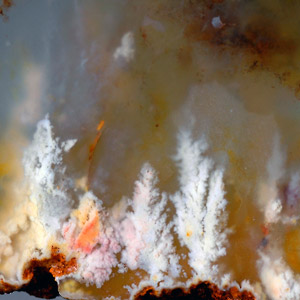 |
|
Nyedigger Plume
|
Graveyard Point Plume
|
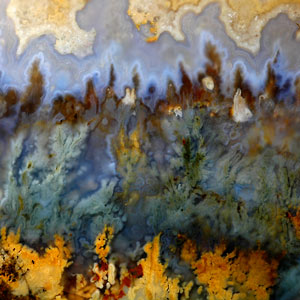 |
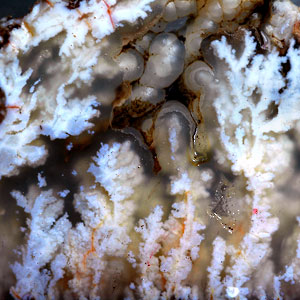 |
|
Prudentman Plume
|
Stinking Water Plume
|
One more named variety of agate is a "sagenite" or sagenitic agate. This describes agate that encases straight needles. The needles are often radiating in hemispheres and like plume agates they are often found at the agate bedrock boundary. Although completely spherical single structures can be found apparently floating in the chalcedony. These spherical sagenites are sometimes referred to as PomPom agate.
It is more difficult to understand how nearly perfectly placed needles can form after the chalcedony as hardened or even gelled, so it may be the case that the needles formed first in the cavity and were later incorporated in to the growing agate. However they are formed they provide yet another type of structure found in agate.
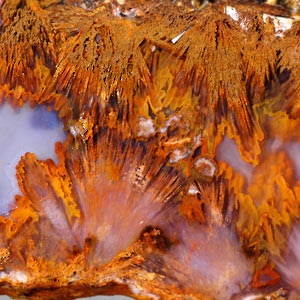 |
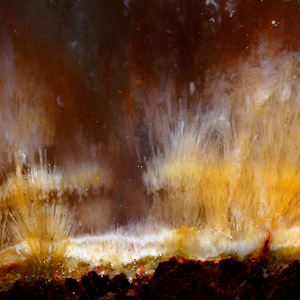 |
|
Sagenite
|
Sagenite
|
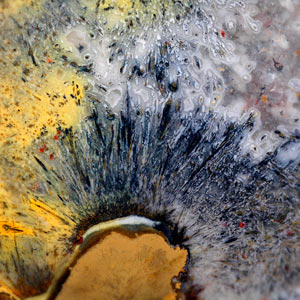 |
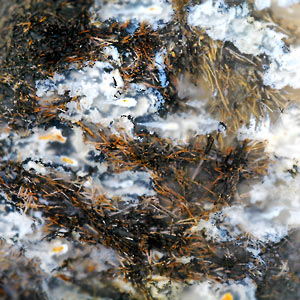 |
|
Sagenite
|
Sagenite
|
There are many other "named" agates beyond the ones thus far described, and I will show a few below. Keep in mind that one mans "plume" maybe defined as anothers "dendritic", or "moss". There is no clear distinction and one form often flows into the next. Many agates contain more than one structure and some may contain all thus far described. The chemistry and the conditions during the formation may change and we are talking about a geologic process here that can take from tens of years to millions of year.
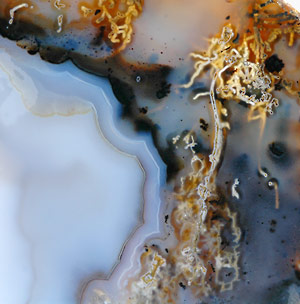 |
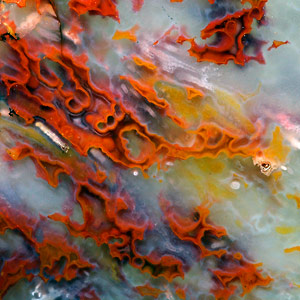 |
|
Black Skin Agate - India
|
Bull Canyon Agate
|
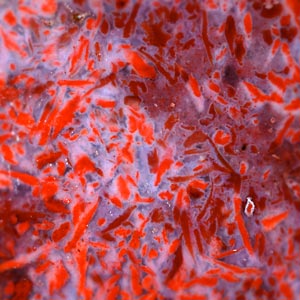 |
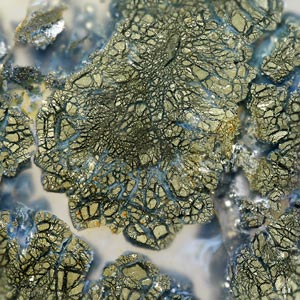 |
|
Confetti Agate
|
Nipomo Marcasite Agate
|
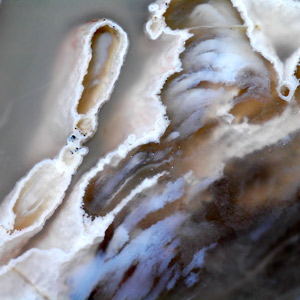 |
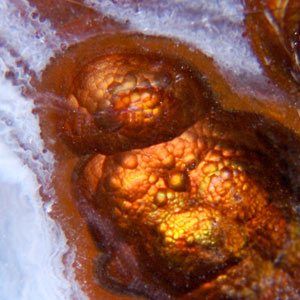 |
|
Keegan Ranch Tube Agate
|
Fire Agate
|
New agates are being discovered each year, and there are others that are only now being formed, it is a continuous process Agates form some of the most remarkable and beautiful structures in nature. It no wonder that they have maintained their popularity throughout history. They been found in ancient Egyptian burial sites in jewelry and will likely continue far into the future.
Please enjoy the remainder of the cabochons photographed below and you will see even more types of stones and structures. For further information on agates with inclusions try this link.
|

